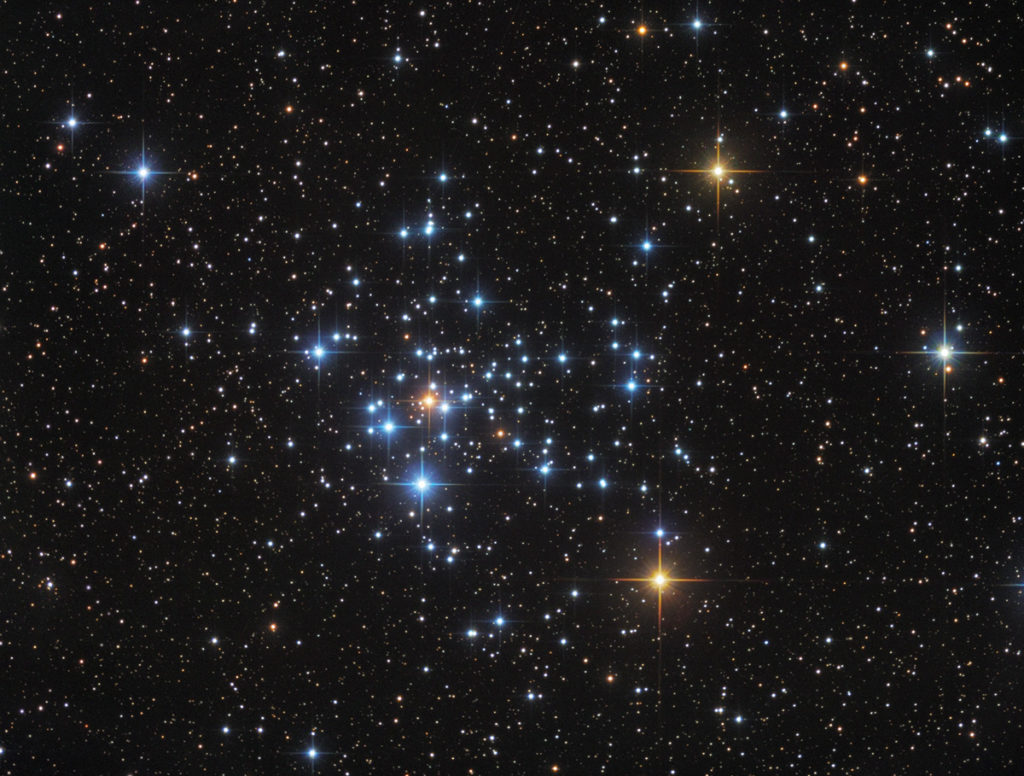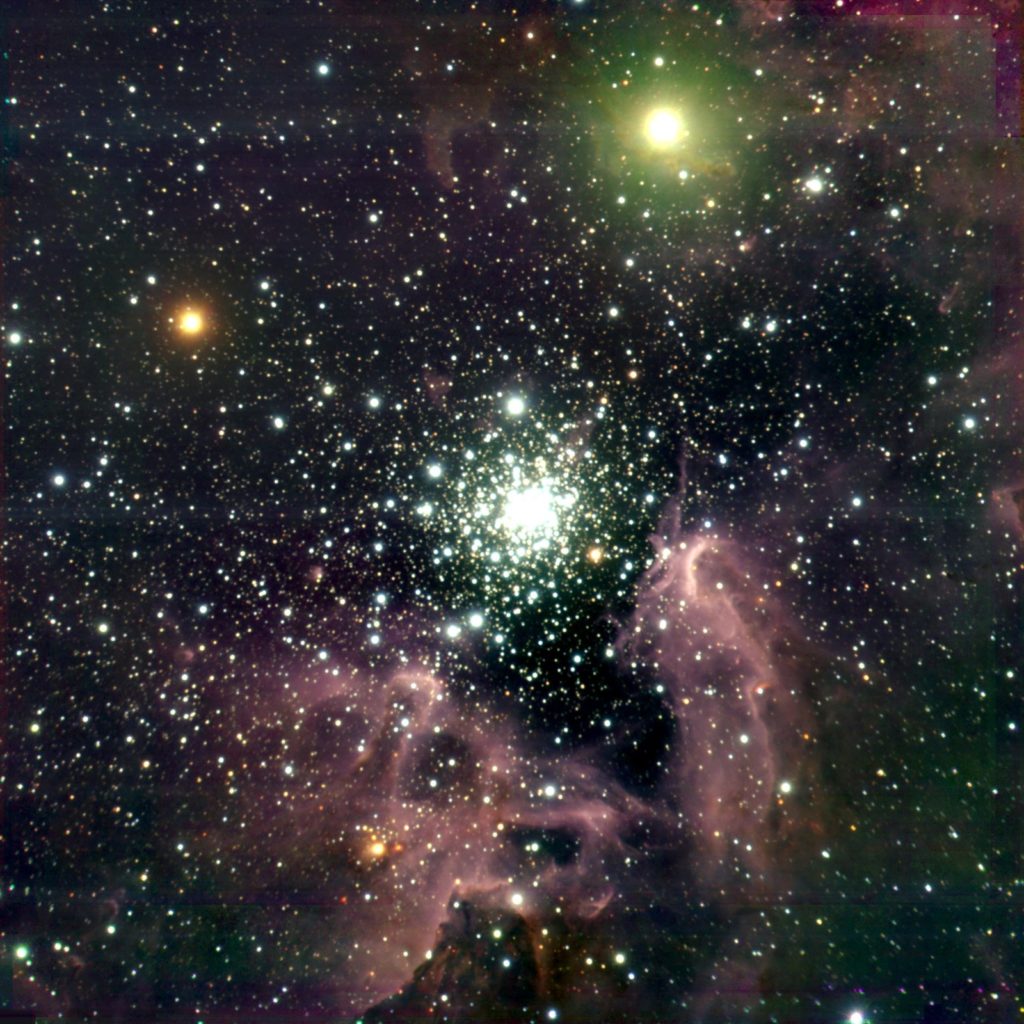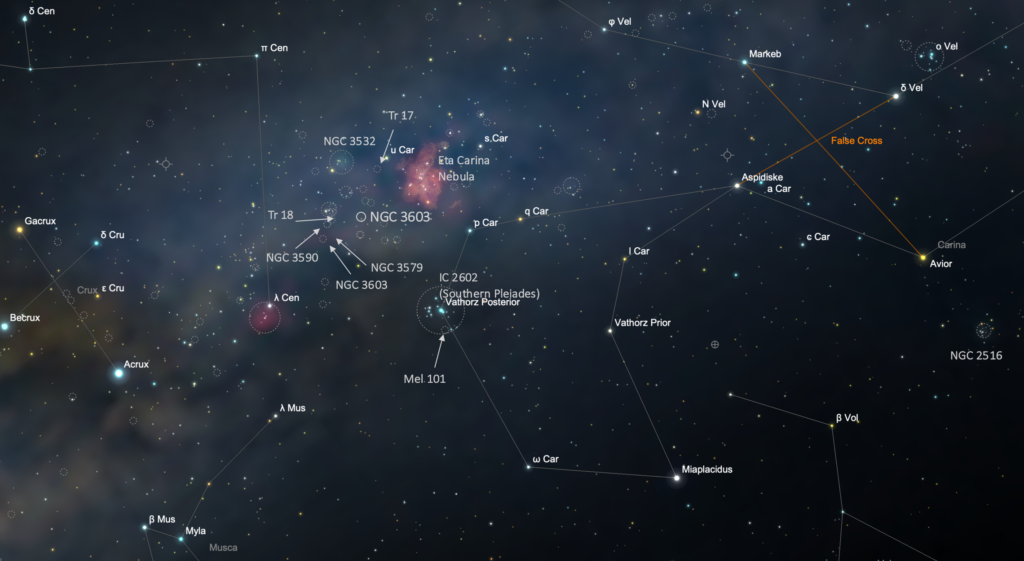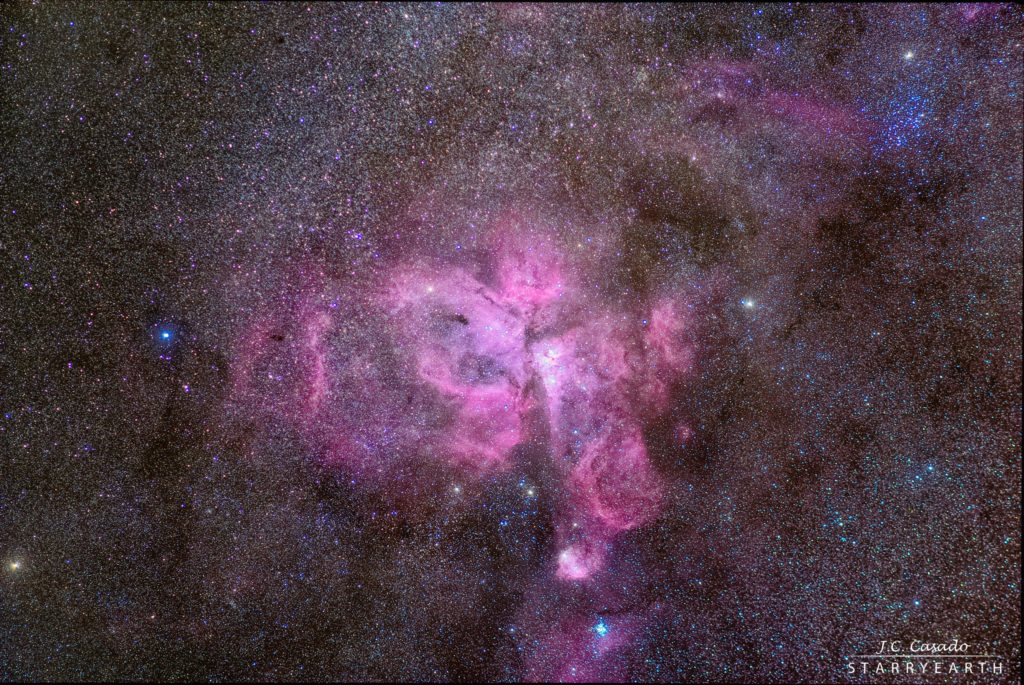
In dark sky, northern-hemisphere observers can see the winter Milky Way as a featureless, inconspicuous band of haze running east of Orion and disappearing below the horizon south of the constellations Canis Major and Puppis. In light-polluted sky, the winter Milky Way is hard to see at all. But further south, into the far southern constellation Carina, the Milky Way suddenly explodes into one of its brightest, most spectacular, and most detailed sections, running through Crux, Centaurus, and beyond.
The Milky Way in the constellation Carina is a playground for anyone with good sky and a decent telescope, and that’s where I poked around with my 92mm refractor on a fine, dark New Zealand night. I began my tour of this part of the sky with the mighty open star cluster NGC 3532. A conspicuous fuzzy patch to the naked eye, this cluster is revealed in a low-power telescope as an amazing sight, surely one of the finest clusters in the entire sky. It easily stands out in an already rich background along the southern Milky Way. The cluster is almond-shaped, oriented generally east-west, and consists of a hundred or more fairly bright stars of similar brightness, which I estimated as magnitudes 6 to 8. It’s nearly a degree long, with distinct boundaries, and it neither peters out gradually into the background nor shows any concentration toward the center. It reminds me of a broad, glittery, silvery fish, minus the tail. It looks like a snapper, a fish I saw someone pull out of the water here in New Zealand’s Bay of Islands. In fact, I’m dubbing it the “Snapper Cluster”. Now I’ll see if that name catches on. The eye of the cluster is marked by a particularly prominent 6th-magnitude orange star. The cluster’s stars are distributed pretty uniformly, though there is a circular empty patch within it. It shares a field with ξ (Xi) Carinae, a much brighter, yellow-orange star of 4th magnitude. The video below, courtesy of ESO, zooms in on this beautiful star cluster:
Next we come to Trumpler 17, a far less conspicuous cluster lying between NGC 3532 and the great Eta Carinae nebula itself. It shares a 50x field with the bright star μ (Mu) Carinae. Using averted vision, I can make out about 15 stars in this small cluster with my 92mm refractor. It features a pair of somewhat brighter stars, with most of the remainder flowing off in the direction of Mu Carinae.
NGC 3603, still in Carina, is an interesting object whose true nature was not apparent in my little telescope. Described by others as a nebulous cluster, to me it appeared as a bright star with a vague fan of nebulosity lying off to one side. At 86X that “star” looked peculiar, slightly fuzzy or nebulous. At the time I thought it might be immersed in a particularly bright patch of nebulosity, but my later investigation revealed that this “star” is actually an extremely compact open cluster known as HD 97950. This cluster turns out to be one of the densest in our galaxy, composed of some of its brightest stars, and lying at a relatively great distance of 20,000 light years. Averted vision makes the general layout of the associated nebula easier to make out. That remote nebula, which looks so inconspicuous, is actually among the biggest and most massive star forming regions in our galaxy.

NGC 3579 is another small nebula; it’s found slightly west of NGC 3603. Faint, small nebulae are among the most challenging targets for a small aperture, and this one is no exception. Photos reveal a complex structure with sweeping arcs, but the best I could do with averted vision, my little scope, and 86x was to make out a faint nebulous zone beaming out from a somewhat brighter field star. I had a vague impression that it was bifurcated by a dark lane, but that was truly a marginal observation with my equipment.
NGC 3590 is a very compact open cluster not far from the nebulae discussed above. It’s prominent and eye catching, but not exactly packed with stars. At 86x I see only four reasonably bright stars arranged like a tiny version of the constellation Corvus. The whole thing spans only a couple of arc minutes.
Also nearby is open cluster Trumpler 18. It’s several times larger than NGC 3590, a scattered group showing about a dozen fairly prominent stars contained in a shape like a rectangle with badly banged up sides. Averted vision shows an underlying mass of very faint stars, indicating that this object would gain a lot of visual interest in a substantially bigger telescope.
Located in an emptier quarter of Carina, the open cluster NGC 2516 is found near the asterism known as the False Cross, a couple of degrees west of the star Avior, or Epsilon Carinae. Clearly visible to the naked eye, this is another of the greatest clusters in the sky (see image at top of page). At 50x, it stretches across half the field, a very irregular, scattered group with many stars of magnitude 6-10. My impression of its overall shape is a hollow circlet resting on a sparkling bed or platform of stars, maybe a representation of a moonrise drawn with stars. I make no guarantee that you’ll see this too. Many of us have a tendency to play connect the dots with stars, and all our interpretations are subjective. Partly it depends on which stars the viewer perceives as being members of the cluster. For example, a little north of NGC 2516 lies a sort of curved triangle composed of four stars of magnitude 5 or 6. Together they resemble a lateen sail. Add that to the star pattern already described and you have a neat little celestial sailboat.

Then there’s IC 2602, known as the Southern Pleiades. I’m not sure why a Southern Pleiades is necessary, because the regular Pleiades are also visible from here at this time of year, though they lie fairly low in the north. Here in New Zealand they often go by their Maori name of Matariki.
IC 2602 is easily visible to the naked eye, but is not really a match for the Pleiades. It features a scattered field of thirty or more stars spread across a degree of sky, ranging from magnitude 3 on down. That 3rd magnitude beacon sometimes goes by the fanciful name of Vathorz Posterior, at least according to Sky Safari. The name apparently pertains to the star’s position along the waterline of the great mythological ship Argo, of which Carina represents the keel. A more scientific designation is Theta Carinae. This is an extremely luminous star that seems destined to blow up as a supernova one fine day.
Of greater interest to me, at least, is the fainter embedded cluster Melotte 101. This is a small, round cloud of about thirty faint stars that I could make out. It’s a much more subtle and, to me, more intriguing sight than the grand splash of stars beyond which it lurks.

We’ve danced around it long enough, so to conclude, let’s take in the overwhelming sight of the Eta Carinae Nebula. Fully describing this fantastic thing and all the stars and clusters it encompasses would take a column of its own, but, in brief…wow! It overflows a one degree field at 100x, and is embedded in a riot of stars. Deep black lanes divide the nebulosity into three major lobes. The most prominent star in the field is the troubled and unstable hypergiant η (Eta) Carinae itself, which appears yellow to me, despite its hot (blue) spectral classification of B0, probably because of filtration by the dense nebula that obscures the star’s true brightness. That nebula appears to be dissipating, leading to predictions that the star will steadily brighten from its current 4th magnitude. Eta is part of a cluster called Trumpler 16, which can hardly be distinguished as a cluster because of the dominance of Eta and the general profusion of stars in the area. Another prominent star in the vicinity is the 4th magnitude red star w Carinae, a foreground object and a variable star. Eta is another likely candidate to blaze up as a supernova, any millennium now.
It’s hard to overstate the visual impact of this spectacular field. Even without the nebula, the density of stars seen here would be memorable. With the nebula, you are privy to an unforgettable view of the depth and richness of our galaxy. Eta Carinae doesn’t need my help to find eager observers. Most of the objects I describe in my columns will be more humble, lesser known, more in need of visitation, and sometimes more challenging.
Share This: